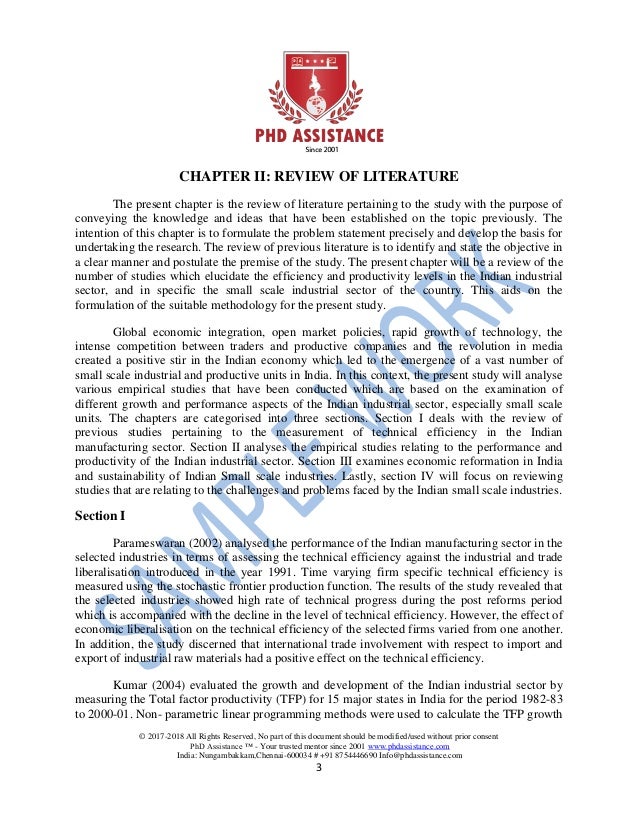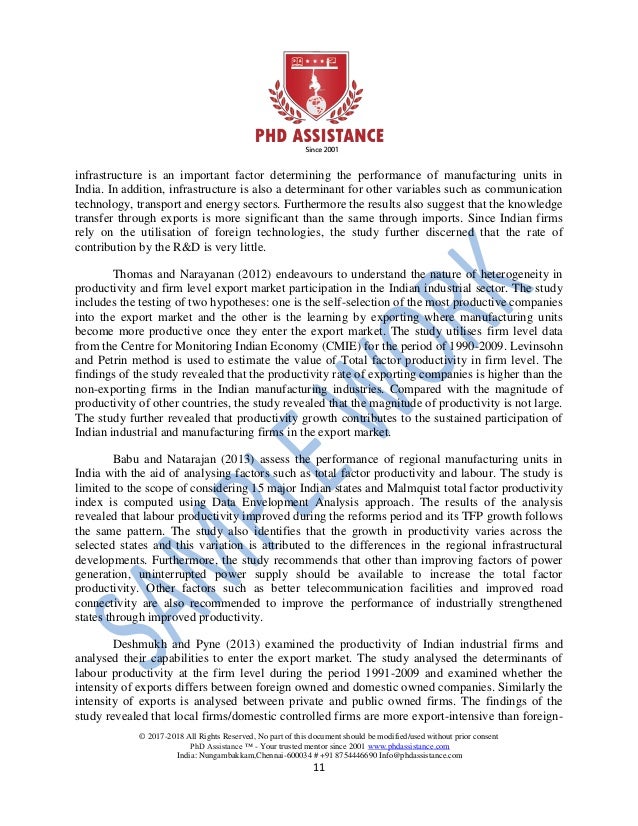
A literature review is a survey of scholarly sources that provides an overview of statement or the study’s goals or purpose. *This sample paper was adapted by the Writing Center from Key, K.L., Rich, C., DeCristofaro, C., Collins, S. (). Use of P ropofol and emergence agitation in children: A literature review. AANA Journal, 78(6 File Size: KB · I am yet to write a Ph.D. literature review in English Literature on Kazuo Ishiguro. This article boosted me up to the importance of Critical and analytical thinking rather than descriptive thinking. I am also a blogger of Ph.D. blogger.com But this information I have not written anywhere on my blog. Thanks for all efforts blogger.com This example shows how a literature review from a PhD thesis can be analysed for its structure, purpose and content. Three sections of the thesis are analysed to show the: relationship between the introduction and the literature review; structure and purpose of dedicated literature review chapters
What Is a PhD Literature Review? | DiscoverPhDs
To browse Academia, literature review phd example. edu and the wider internet faster and more securely, literature review phd example, please take a few seconds to upgrade your browser. Skip to main content. edu no longer supports Internet Explorer. Log In Sign Up. Download Free PDF, literature review phd example. phd literature review sample pdf. PhD Assistance.
Download PDF. Download Full PDF Package This paper, literature review phd example. A short summary of this paper. READ PAPER. The intention of this chapter is to formulate the problem statement precisely and develop the basis for undertaking the research. The review of previous literature is to identify and state the objective in a clear manner and postulate the premise of the study.
The present chapter will be a review of the number of studies which elucidate the efficiency and productivity levels in the Indian industrial sector, literature review phd example, and in literature review phd example the small scale industrial sector of the country. This aids on the formulation of the suitable methodology for the present study. Global economic integration, open market policies, rapid growth of technology, the intense competition between traders and productive companies and the revolution in media created a positive stir in the Indian economy which led to the emergence of a vast number of small scale industrial and productive units in India.
Literature review phd example this context, the present study will analyse various empirical studies that have been conducted which are based on the examination of different growth and performance aspects of the Indian industrial sector, especially literature review phd example scale units.
The chapters are categorised into three sections. Section I deals with the review of previous studies pertaining to the measurement of technical efficiency in the Indian manufacturing sector, literature review phd example. Section II analyses the empirical studies relating to the performance literature review phd example productivity of the Indian industrial sector. Section III examines economic reformation in India and sustainability of Indian Small scale industries.
Lastly, section IV will focus on reviewing studies that are relating to the challenges and problems faced by the Indian small scale industries, literature review phd example. Section I Parameswaran analysed the performance literature review phd example the Indian manufacturing sector in the selected industries in terms of assessing the technical efficiency against the industrial and trade liberalisation introduced in the year Time varying firm specific technical efficiency is measured using the stochastic frontier production function.
The results of the study revealed that the selected industries showed high rate of technical progress during the post literature review phd example period which is accompanied with the decline in the level of technical efficiency.
However, the effect of economic liberalisation on the technical efficiency of the selected firms varied from one another. In addition, the literature review phd example discerned that international trade involvement with respect to import and export of industrial raw materials had a positive effect on the technical efficiency. Kumar evaluated the growth and development of the Indian industrial sector by measuring the Total factor productivity TFP for 15 major states in India for the period to The growth measured through TFP is disintegrated into efficiency and technological changes and the bias in the technical change is also measured.
The results obtained from the use of non- parametric linear programming methods are used to examine whether economic liberalisation had positive impacts on the efficiency and productivity in the Indian economy.
Post and pre reforms period analysis was conducted, literature review phd example. The findings of the study revealed significant growth in the Indian economy after liberalisation. The growth is attributed to the changes in TFP which is governed by the progress in technical aspects, literature review phd example. The progress in technological aspects in the productive sector of the state exhibited a capital bias during the period of study.
The differences in the region wise TFP is evident; however, the difference in the variation significantly declined in the post —reforms period. In addition, it is also found that the rate of TFP growth is converging among the different states of literature review phd example country during the post- reforms period and those states which were efficient technically during the post-reforms period had significant growth. Sivakumar and Patnaik n. estimated and analysed the efficiencies of the Indian industrial sector in terms literature review phd example technical productivity within the period to The study covered literature review phd example industries and calculated their efficiency within the specified time period.
The study is aimed to capture the technical efficiency behaviour during the pre and post economic reforms period, literature review phd example. Time-varying stochastic frontier production function in the transcendental logarithmic form is employed in the study wherein the analysis using the selected methodology revealed that the efficiency of the selected industries in the period of to The findings of the study revealed that the effects of industry specific inefficiency hinder the growth of production in the selected industries in achieving the maximised output.
Other factors such as weather, strikes and luck are neglected in the study. The study further identifies that the technical efficiency of the selected industries is low in post —reforms period when compared with that of the pre-reforms period. Madheswara et al. Sector level data literature review phd example the Indian industrial sector was used for the analysis. The study is concentrated on the trends of technical efficiency change TEC and technical progress TP.
Stochastic Production Frontier analysis is employed in the study to segregate the two principal components, technical efficiency change TEC and technical progress TP. This process of segregation is also used to recognise the growth in productivity which could be either due to improvement in efficiency or progress in technology. The significance of utilising the frontier approach as an alternative to the traditional index number approach to measure the growth of productivity lies within the identification of unobservable and idealized production possibility frontier with production-unit specific one-sided deviation from the frontier.
Henceforth, the Stochastic Production Frontier analysis method captures the change in efficiency and the change in technologies as the constituting parts of the change in productivity which is an additional dimension for literature review phd example of policy perspectives. The results of the study suggest that during the periodthe total factor productivity growth in a majority of companies improved when compared with the same during the pre-reforms period, and in specific In addition, the study findings also revealed that the TFP growth is steered by progress in technology and technological change adaptation in the companies rather than change in technical efficiency.
Bhaumik and Kumbhakar employed the use of plant-level data for the years between and in order to assess if the growth that occurred after resulted in the use of resources more efficiently. This is inclusive of the assessment for factor inputs inclusive of capital. Other findings of the study included the alteration of the technical efficiency.
This was evidenced with the decline in the median technical efficiency across all industries except one in the set timeline as above, however, this change in the technical efficiency offers a partial explanation as to the change in the added gross value. The analysis of the research points to the aspects of the increase in return for the factor inputs in these two years which explains the change in gross value increase across these industries more adequately.
Another study by Mazumdar et al. The study employs a non-parametric approached of Data Envelopment Analysis DEA, literature review phd example. The analysis reveals that even though literature review phd example efficiency outputs were found to be declining, the evidence also depicted that resources were being made use of adequately in this period.
Mitra et al. The study was carried out from in the Indian manufacturing industry. In this study advanced estimation techniques are used in order to counteract the existing limitations such as non-stationary omitted variables, reverse causality and endogeneity.
This was carried out by the application of a fully modified OLS, literature review phd example, panel co- integration and also system GMM. The findings of the study reveal that infrastructure and the IT with communicative technology are strongly associated with the technical efficiency. The implications of the findings are that the improvement in the infrastructure and the IT components of the firm can aid to the enhancement of these sectors further improving the competitive edge for India.
The findings also shed light on the current scenario of infrastructure in India. Bhandari et al. This was done to measure the technical and scale efficiency changes that occurred before and after as per the reform initiatives.
It was found that the efficiency of the industries declined in the post reform period as compared to the pre reform period. These implied that the findings are rather significant for the manufacturing industries but also implies that the changes are varied across different industries.
Another study conducted by Kathuria et al. This study too employed the use of advanced estimation techniques such as non-parametric accounting, semi-parametric product function accounting for endogeneity and parametric stochastic production frontier to measure the total factor productivity TFP.
The study assessed the same for the periods of and The study findings reveal that the TFP for both the formal and informal sectors differed vastly over the timeframe. There was a decline in the TFP in the formal sector between and In the case of the informal sector, all the three methods showed a decline in TFP for This evidences that the inconsistencies in the measure for TFP exist, especially between the formal and informal sectors of the manufacturing industry.
Baliyan et al. State-wise productivity change and efficiency are measured using the Data Envelopment Analysis DEA approach which is calculated over the period of to The period is divided into pre-liberalisation tofirst phase of post-liberalisation to and second phase of post-liberalisation to Total Factor Productivity TFP change is calculated using the non- parametric Data Envelopment Analysis DEA approach.
In addition, the paper evaluates the performance metrics of the major inputs used in the Indian industrial sector and reveals the reasons for inefficiency across the different segments. The findings of the study revealed that the productivity growth and efficiency vary across the different states in the country. Translog stochastic frontier production function is used in the present study to assess the technical progress and technical efficiency of the industries in the era of economic reformation.
The findings of the study revealed that the electronic manufacturing units in India experience improvements in the technical progress during the period of to However, the mean level of technical efficiency of the firms had a declining rate during the same period.
The study thereby discerns that a majority of companies failed in spite of the Information Technology Agreement ITA of World Trade Organization WTO implementation and such implementation does not impact the technical efficiency of the electronic manufacturing firms.
Section II Unel analysed the trends of productivity in the manufacturing sector of India during the period of to The findings of the study revealed that the labour and total factor productivity TFP growth in the Indian industrial sector were significantly higher till the s; however, the accelerated growth of the Literature review phd example is attributed to factor elasticities and the production literature review phd example structure.
The productivity growth of the manufacturing as well as the subsectors improved after the liberalisation. In the same context, Banga and Goldar assessed the contribution of services to the productivity and output growth of the Indian industrial sector during the pre and post reforms period.
The KLEMS capital-labor-energy-materials-services production function framework is used to analyse the contribution of the services to the productivity and growth of the Indian manufacturing sector. The utilised production framework literature review phd example services as inputs to the process of production. The study used panel data of three-digit level industries during the time frame of to 18 years and the data is used to estimate the production function, literature review phd example.
The results of the analysis revealed that the increasing use of services brought favourable effects on the productivity and output growth of the Indian manufacturing sector in the s. It is also to be noted that such favourable could even be due to the economic liberalisation that was carried out.
Literature Review with Practical Example
, time: 4:18How to be critical in a PhD literature review - The PhD Knowledge Base

· Using this mind map, you have to organise the literature review. This means that you need to pick up one primary idea and then write an essay about that by relating it with the literature you have read. For example, you chose the concept "Misuse of Drugs Act " · I am yet to write a Ph.D. literature review in English Literature on Kazuo Ishiguro. This article boosted me up to the importance of Critical and analytical thinking rather than descriptive thinking. I am also a blogger of Ph.D. blogger.com But this information I have not written anywhere on my blog. Thanks for all efforts blogger.com The review of previous literature is to identify and state the objective in a clear manner and postulate the premise of the study. The present chapter will be a review of the number of studies which elucidate the efficiency and productivity levels in the Indian industrial sector, and in specific the small scale industrial sector of the country

No comments:
Post a Comment